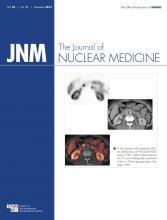TO THE EDITOR: With considerable interest we have read the recent report by Van Nostrand et al. in which the authors compared the proportion of patients with positive scans and the number of lesions detected during diagnostic 131I whole-body scintigraphy and 124I PET/CT in patients prepared with either recombinant human thyroid-stimulating hormone (rhTSH) or conventional thyroid hormone withdrawal (THW) (1). The authors reported that considerably more patients were “positive” both on diagnostic 131I whole-body scintigraphy and on 124I PET/CT after THW than after rhTSH. The entire study appears methodologically geared toward comparing 131I with 124I. It would therefore have been interesting to see further statistical analyses on the comparison of these 2 well-established radioisotopes, especially if the authors additionally would have acquired and evaluated 131I SPECT/CT (2). Instead, the authors performed an analysis of the differences between rhTSH and THW.
Furthermore, the authors surprisingly did not use 124I-PET to perform dosimetry for their patients, which in our opinion would have been clinically relevant especially in those patients with metastatic lesions (3) because it is well known that the visualization of metastases does not automatically translate into the possibility of an effective 131I treatment (4,5).
Besides these aspects, we see major drawbacks in the interpretation of the presented data based on the rather weak methodology. The authors already point out in their discussion that patients were not randomized as to the method of preparation, nor was any patient scanned after preparation with both rhTSH and THW. An intraindividual comparison would, however, represent the gold standard for a head-to-head study, especially when taking into account the heterogeneous patient sample. Instead, the decision as to the rhTSH stimulation method was made by referring endocrinologists, whose criteria were subjective, not systematically recorded, and not otherwise reported by Van Nostrand et al. Accordingly, there may well have been a bias between the 2 groups, even though the authors found no statistical difference between the 2 groups regarding age, sex, thyroglobulin level, urine iodine level, type of histology, or indications on the order form. Nonetheless, other variables such as the results of prior tests (e.g., cervical ultrasound) and patient history—including TNM stage (6)—which might have influenced the clinical indication, were not included in the analysis. Of note, all 3 patients with a less favorable prognosis (insular, tall cell, poorly differentiated histology) and a greater likelihood of dedifferentiation were treated in the rhTSH group (12.5% of that group). Furthermore, the paper does not differentiate whether lesions concerned thyroid remnants or locoregional metastases—assuming that any cervical lesion concerned the latter—whereas the former according to recent literature would have essentially been clinically irrelevant (especially in the context of undetectable thyroglobulin levels). In addition, no data are given in which iodine uptake in distant metastases is compared between the 2 methods of stimulation.
The authors state that their result is most consistent with the data of Freudenberg et al. (7) but do not reflect that the conclusion of Freudenberg et al. was far more cautious (“In conclusion, we found some suggestions, but no statistically significant evidence, that rhTSH stimulation may result in a lower radiation dose to advanced [differential thyroid carcinoma] lesions per GBq of administered activity than does THW stimulation.”)
A large, multicenter, multinational prospective study (220 patients with evaluable diagnostic scintigraphs) by Haugen et al. performed an intraindividual comparison of preparation with hypothyroidism and rhTSH for diagnostic 131I whole-body scintigraphy. The 2 modalities were comparable in their diagnostic yield: with respect to 49 patients with distant metastases, 39 (80%) were judged by masked independent readers to have concordant diagnostic scans, 2 (5%) to have superior rhTSH scans, and 8 (16%) to have superior THW scans (P = 0.109) (8). This finding was crucial for the regulatory approval of rhTSH to prepare patients for diagnostic 131I whole-body scintigraphy.
Given the aforementioned methodologic constraints, the conclusion that “physicians should be cautious in using rhTSH for patient preparation before diagnostic scanning for the detection of [differential thyroid carcinoma]…with 131I” seems far too strong, especially when regarding the tremendous burden that THW poses on patients both medically and in terms of decreased quality of life. On the other hand, it is obvious that the therapeutic use of rhTSH in patients with metastases is not covered by the current label in Europe or the United States and must be considered experimental.
As our respected colleagues already elaborate: “A prospective study in which each patient is studied using both methods of preparation is warranted.” Although we would very much welcome and would gladly participate in such a study, we would also welcome a more nuanced view on the data presented in the study by Van Nostrand et al.
Footnotes
Published online Aug. 30, 2012.
- © 2012 by the Society of Nuclear Medicine and Molecular Imaging, Inc.







